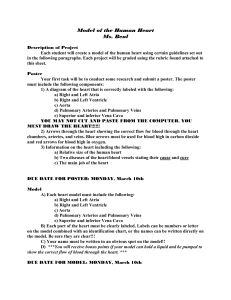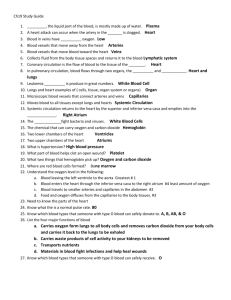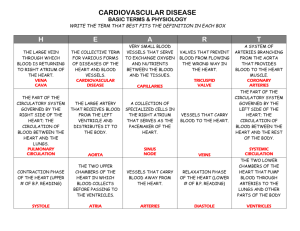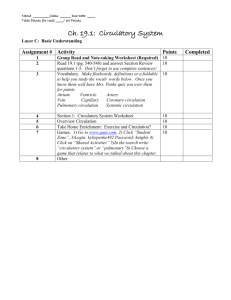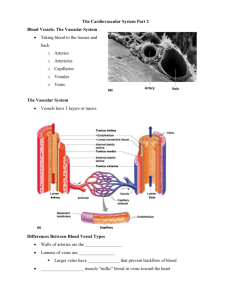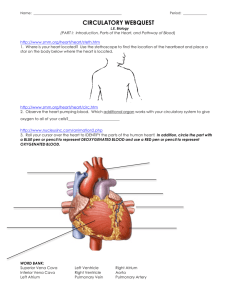Circulatory System WARM-UP
advertisement
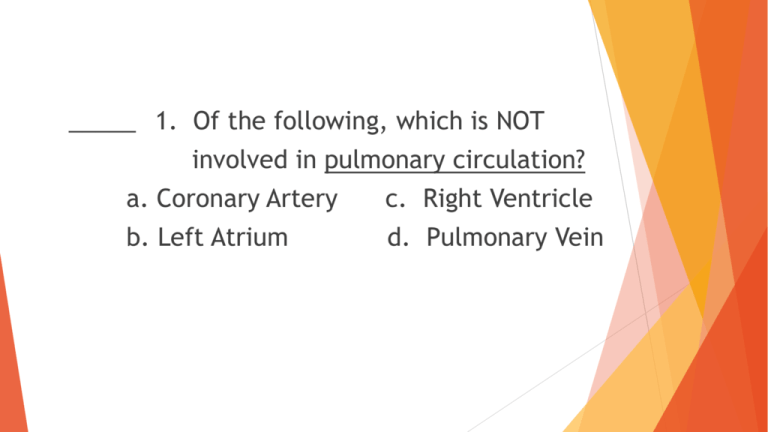
_____ 1. Of the following, which is NOT involved in pulmonary circulation? a. Coronary Artery c. Right Ventricle b. Left Atrium d. Pulmonary Vein a. CORONARY ARTERY _____ 2. The heart of a human contains ______ chamber(s). a. One c. three b. Two d. four d. FOUR _____ 3. Blood is a tissue that consists of ____________. a. Cells c. liquid b. Cell fragments d. all of the above d. all of the above _____ 4. Of the following, which is NOT involved in systemic circulation? a. Aorta c. inferior vena cava b. Superior vena cava d. Pulmonary artery d. Pulmonary artery _____ 5. Of the following, which is NOT a function of blood? a. Digestion c. Carries oxygen b. Carries waste products d. Carries nutrients a. Digestion MATCH THE ANSWER WITH THE GIVEN QUESTION a. b. c. d. e. Capillaries Pulmonary circulation Arteries Systemic Circulation Blood Pressure _____ f. g. h. i. Atria Coronary circulation Ventricles Veins 6. Upper chambers of the heart f. Atria (plural form of Atrium) MATCH THE ANSWER WITH THE GIVEN QUESTION a. b. c. d. e. Capillaries Pulmonary circulation Arteries Systemic Circulation Blood Pressure _____ f. g. h. i. Atria Coronary circulation Ventricles Veins 7. Vessels that move blood toward the heart i. Veins MATCH THE ANSWER WITH THE GIVEN QUESTION a. Capillaries f. Atria b. Pulmonary circulation g. Coronary circulation c. Arteries h. Ventricles d. Systemic Circulation i. Veins e. Blood Pressure _____8. Vessels that move blood away from the heart c. arteries MATCH THE ANSWER WITH THE GIVEN QUESTION a. Capillaries f. Atria b. Pulmonary circulation g. Coronary circulation c. Arteries h. Ventricles d. Systemic Circulation i. Veins e. Blood Pressure _____9. The flow of blood to the tissues of the heart g. Coronary Circulation MATCH THE ANSWER WITH THE GIVEN QUESTION a. b. c. d. e. Capillaries Pulmonary circulation Arteries Systemic Circulation Blood Pressure _____ f. g. h. i. Atria Coronary circulation Ventricles Veins 10. A forced exerted on the walls of blood vessels by blood e. Blood pressure MATCH THE ANSWER WITH THE GIVEN QUESTION a. Capillaries f. Atria b. Pulmonary circulation g. Coronary circulation c. Arteries h. Ventricles d. Systemic Circulation i. Veins e. Blood Pressure _____11. Tiny blood vessels that connect arteries and veins. a.Capillaries MATCH THE ANSWER WITH THE GIVEN QUESTION a. Capillaries f. Atria b. Pulmonary circulation g. Coronary circulation c. Arteries h. Ventricles d. Systemic Circulation i. Veins e. Blood Pressure _____ 12. The flow of blood to all body tissues except heart and lungs. d. Systemic Circulation MATCH THE ANSWER WITH THE GIVEN QUESTION a. Capillaries f. Atria b. Pulmonary circulation g. Coronary circulation c. Arteries h. Ventricles d. Systemic Circulation i. Veins e. Blood Pressure _____13. Lower chambers of the heart. h. Ventricles MATCH THE ANSWER WITH THE GIVEN QUESTION a. Capillaries f. Atria b. Pulmonary circulation g. Coronary circulation c. Arteries h. Ventricles d. Systemic Circulation i. Veins e. Blood Pressure _____ 14. The flow of blood through the heart to lungs and back to the heart b. Pulmonary circulation 15. Why is the pulmonary vein the only oxygen-rich vein in the body? Because it brings blood to the heart from the lungs, where it picks up oxygen. 16. What is the purpose of Pulmonary Circulation? To take blood to the lungs to release carbon dioxide and pick up oxygen for respiration. 17. Describe systolic and diastolic blood pressure… Systolic- When the ventricles contract and blood is pushed out of the heart.(Top # of blood pressure) Diastolic- A measure of the pressure that occurs as the ventricles fill with blood just before they contract again. (Bottom # of blood pressure) Example BP: 120/80 18. Why are there no valves in arteries? Blood in arteries is pushed along by the pumping of the heart and the smooth muscles of the artery walls. 19. What are some steps you can take to prevent cardiovascular disease? Regular checkups, a healthful diet, exercise, maintaining a healthy weight, reducing stress, not smoking. 20. Capillaries, Veins and Arteries are all__________. BLOOD VESSELS What is “A” called? RIGHT ATRIUM What is “B” called? SUPERIOR VENA CAVA What is “C” called? AORTA What is “D” called? PULMONARY ARTERY What is “E” called? LEFT ATRIUM What is “F” called? LEFT VENTRICLE What is “G” called? RIGHT VENTRICLE What is “H” called? INFERIOR VENA CAVA WHAT ARE THE TWO LARGEST VEINS IN THE BODY? THE SUPERIOR VENA CAVA AND THE INFERIOR VENA CAVA Blood comes from the __________________ to the SUPERIOR VENA CAVA HEAD AND NECK Blood comes from the __________________ to the INFERIOR VENA CAVA. THE LOWER BODY
